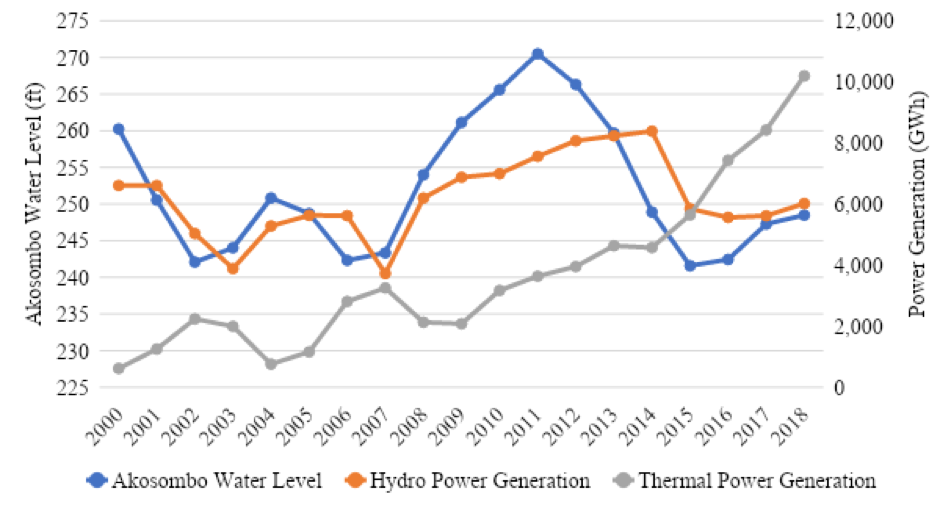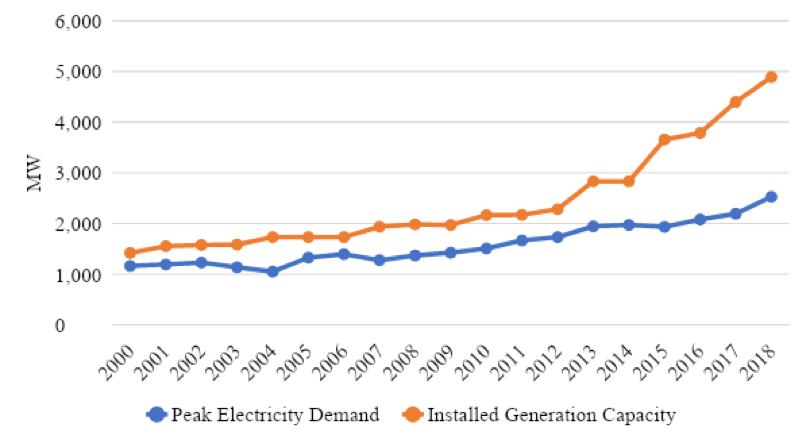‘Dumsor,’ which means ‘off-on’ in the Akan language, has become a household name for the persistent and erratic power outages in Ghana. The country has experienced multiple power crises since independence: 1982-84, 1998-2000, 2006-07, and the latest situation which has been intermittent since 2012. Dumsor has had a significant toll on the economy. Nearly 50% of the country’s small-scale industries lose several hours each month due to lack of reliable power, while the rest resort to costly generators. Overall, outages reduced GDP by an estimated 2% in 2014 alone and was associated with a surge in job losses in 2015.
Why did it happen?
The Akosombo dam is the single largest source of power in Ghana by far, with installed capacity of 1,020 MW. Dependence on this one dam triggered the early power crises as severe droughts caused unseasonably low water levels. Following those episodes, sector reforms enabled participation from Independent Power Producers (IPPs), which led to a gradual increase in the total generation capacity from more diverse sources, mainly thermal plants running on crude oil or natural gas (Figure 1). The recent power outages have had myriad causes including:
- Continuous decline in rainfall patterns, which restricts production at Akosombo.
- Unreliable natural gas supply, affecting steady operations at Ghana’s 10 thermal plants.
- Fiscal constraints which limited alternative fuel purchases such as crude oil.
- High Transmission & Distribution losses caused by obsolete and poorly-maintained equipment.
Is Dumsor Over?
Since the 2012 crisis began, Ghana has aggressively expanded installed generation capacity, rising to almost twice the peak electricity demand (Figure 2). Historically dominant hydropower has fallen to just 37% of the total share, with nearly all of the rest met by thermal (Figure 1).
Dumsor is over as measured by plenty of installed capacity to supply peak demands. Local gas production from the Ghana National Gas Company has also eliminated dependency on irregular supply from Nigeria through the West Africa Gas Pipeline. Ghana’s compact with the Millennium Challenge Corporation is also investing in upgrading transmission and distribution infrastructure to further reduce losses. Electricity reliability metrics have also improved recently with the average outage frequency dropping by 40% and outage duration by 56% since 2018. While issues of cost — Ghana’s base industrial tariff is a whopping $0.23/kWh — still greatly impact the sector, for now Dumsor appears mostly gone.
FIGURE 1: Impact of Akosombo water levels on power generation proportions

FIGURE 2: Electricity demand versus installed generation capacity

References:
- Ahali, A. Y. (2016). Improving Electricity Access in Ghana Challenges and the Way Forward. International Journal of Energy and Power Engineering. Special Issue: Electricity Market. Vol. 5, No. 2-2, pp. 9-17. doi: 10.11648/j.ijepe.s.2016050202.12
- Braimah, I., & Amponsah, O. (2012). Causes and Effects of Frequent and Unannounced Electricity Blackouts on the Operations of Micro and Small Scale Industries in Kumasi. Journal of Sustainable Development.
- Energy Commission (2014). National Energy Statistics (2000 – 2013). Energy Commission, Accra.
- Energy Commission (2019). National Energy Statistics (2009 – 2018). Energy Commission, Accra.
- Eshun, M. E., & Amoako-Tuffour, J. (2016). A review of the trends in Ghana’s power sector. Energy, Sustainability and Society, 6(9). https://doi.org/10.1186/s13705-016-0075-y
- Kemausuor, F., & Ackom, E. (2017). Toward universal electrification in Ghana. Wiley Interdisciplinary Reviews: Energy and Environment, 6(1), [e225]. https://doi.org/10.1002/wene.225
- Kumi, E. N. (2017). The Electricity Situation in Ghana: Challenges and Opportunities. CGD Policy Paper. Washington, DC: Center for Global Development. https://www.cgdev.org/publication/electricity-situation-ghana-challenges-and-opportunities
- Mathrani, S., Santley, D., Hosier, R., Bertholet, F., Braud, A., Dawson-Amoah, G., Mathur, S., Amissah-Arthur, H., Garcia, R., Adam, M. A., Matthews, B., Sachdeva, A., & Reinoso, G. (2013). Energizing economic growth in Ghana : making the power and petroleum sectors rise to the challenge (English). Washington DC ; World Bank. http://documents.worldbank.org/curated/en/485911468029951116/Energizing-economic-growth-in-Ghana-making-the-power-and-petroleum-sectors-rise-to-the-challenge
- Millennium Development Authority (2014). Ghana Power Compact. Accra; Millennium Development Authority (MiDA). https://www.mida.gov.gh/pages/view/9/A_GH_CompactII.pdf
- World Bank (2020). Doing Business Indicators. https://www.doingbusiness.org/en/data
